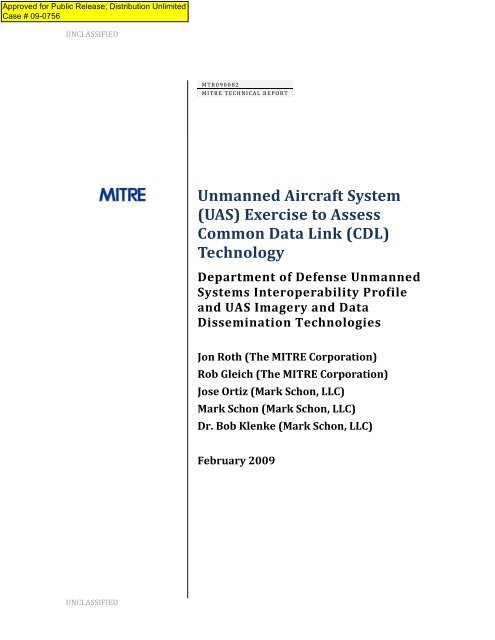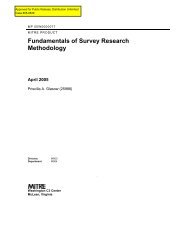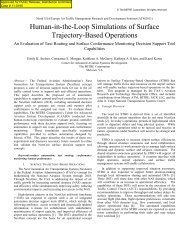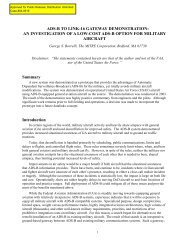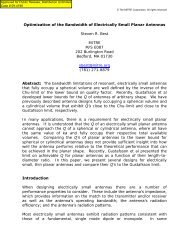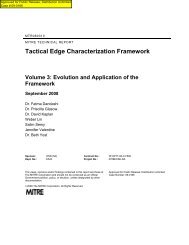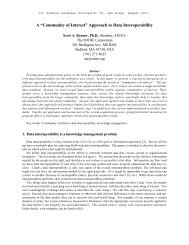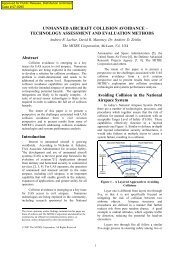Unmanned Aircraft System (UAS) Exercise to Assess ... - Mitre
Unmanned Aircraft System (UAS) Exercise to Assess ... - Mitre
Unmanned Aircraft System (UAS) Exercise to Assess ... - Mitre
Create successful ePaper yourself
Turn your PDF publications into a flip-book with our unique Google optimized e-Paper software.
UNCLASSIFIED<br />
UNCLASSIFIED<br />
MTR090082<br />
MITRE TECHNICAL REPORT<br />
<strong>Unmanned</strong> <strong>Aircraft</strong> <strong>System</strong><br />
(<strong>UAS</strong>) <strong>Exercise</strong> <strong>to</strong> <strong>Assess</strong><br />
Common Data Link (CDL)<br />
Technology<br />
Department of Defense <strong>Unmanned</strong><br />
<strong>System</strong>s Interoperability Profile<br />
and <strong>UAS</strong> Imagery and Data<br />
Dissemination Technologies<br />
Jon Roth (The MITRE Corporation)<br />
Rob Gleich (The MITRE Corporation)<br />
Jose Ortiz (Mark Schon, LLC)<br />
Mark Schon (Mark Schon, LLC)<br />
Dr. Bob Klenke (Mark Schon, LLC)<br />
February 2009
UNCLASSIFIED<br />
Sponsor: PD/SI<br />
Dept. No.: E403<br />
Project No.: 20SPI010-A7<br />
The views, opinions and/or<br />
findings contained in this report<br />
are those of The MITRE Corporation<br />
and should not be construed as an<br />
official government position, policy, or<br />
decision, unless designated by other<br />
documentation.<br />
©2009 The MITRE Corporation.<br />
All Rights Reserved.<br />
UNCLASSIFIED<br />
MTR090082<br />
MITRE TECHNICAL REPOR T<br />
<strong>Unmanned</strong> <strong>Aircraft</strong><br />
<strong>System</strong> (<strong>UAS</strong>) <strong>Exercise</strong> <strong>to</strong><br />
<strong>Assess</strong> Common Data<br />
Link (CDL) Technology<br />
Department of Defense <strong>Unmanned</strong><br />
<strong>System</strong>s Interoperability Profile and <strong>UAS</strong><br />
Imagery and Data Dissemination<br />
Technologies<br />
Jon Roth (The MITRE Corporation)<br />
Rob Gleich (The MITRE Corporation)<br />
Jose Ortiz (Mark Schon, LLC)<br />
Mark Schon (Mark Schon, LLC)<br />
Dr. Bob Klenke (Mark Schon, LLC)<br />
February 2009
UNCLASSIFIED<br />
Executive Summary<br />
On Friday, 31 Oc<strong>to</strong>ber 2008, a MITRE-led team that included MITRE and Mark Schon, Limited<br />
Liability Company (LLC) engineers, government and vendor personnel successfully exercised<br />
the <strong>Unmanned</strong> <strong>System</strong>s Interoperability Profile (USIP) 1 in the field. Mark Schon, LLC in<br />
collaboration with Virginia Commonwealth University (VCU) provided the <strong>Unmanned</strong> <strong>Aircraft</strong><br />
<strong>System</strong> (<strong>UAS</strong>) integration and flight services for the exercise. The exercise was conducted at<br />
Finnegan’s Field in the military restricted airspace of the Fort A.P. Hill ranges near Bowling<br />
Green, Virginia.<br />
Vendor participants in the exercise included Cubic Defense Applications (Cubic), the Mini-<br />
Common Data Link (CDL) provider; Cornet Technology, Inc (Cornet), the Moving Picture<br />
Experts Group (MPEG) – 2 and H.264 Video Encoder/Decoder provider; and Lead Technologies,<br />
a video Software Developers Kit (SDK) provider.<br />
The exercise was observed by key Marine Corps personnel from Marine Corps <strong>System</strong>s<br />
Command (MCSC), the Marine Corps Warfighting Lab (MCWL), the Marine Corps Intelligence<br />
Activity (MCIA) and Headquarters, Marine Corps (HQMC). Key Navy and Marine Corps<br />
personnel from Naval Air <strong>System</strong>s Command (NAVAIR) were also on hand <strong>to</strong> observe. Fort A.P.<br />
Hill Range Operations and Aviation Operations personnel were on hand <strong>to</strong> observe the exercise,<br />
as well. Vendor participants, who generously provided support and equipment for the exercise,<br />
and their company representatives, also attended for a <strong>to</strong>tal of more than forty people<br />
observing the exercise.<br />
In June 2008, USIP 1 was approved by the Office of the Under Secretary of Defense (OUSD) for<br />
Acquisition, Technology and Logistics (AT&L), the Assistant Secretary of Defense (ASD) for<br />
Networks and Information Integration (NII), and the Joint Services <strong>UAS</strong> representatives. USIP 1<br />
pertains <strong>to</strong> the direct communication and receipt of data from the Air Vehicle (AV) <strong>to</strong> the<br />
Ground Control Station (GCS) or Remote Video Terminal (RVT) operating in the Ku Band. The<br />
operational context for this profile is the Transmission, Collection, Production, Exploitation and<br />
Dissemination (TCPED) chain of operational activities. Accordingly, the USIP 1 profile<br />
specifically mandates, defines and standardizes the implementation conventions required for<br />
interoperability of line of sight transmission of motion imagery for battle space awareness<br />
using the Standard Common Data Link (STD-CDL). USIP 1 accomplishes this using the following<br />
layers of the Open <strong>System</strong>s Interconnection Model: (1) Physical, (2) Data Link, (3) Network, (4)<br />
Transport, and (7) Application.<br />
Team activities leading up <strong>to</strong> the exercise involved the integration of multiple USIP 1-compliant<br />
components in<strong>to</strong> the Outlaw AV and the ground systems. Two Outlaw <strong>Unmanned</strong> <strong>Aircraft</strong> (UA)<br />
were outfitted with the VCU Flight Control <strong>System</strong> (FCS) au<strong>to</strong>pilot and flight tested in July 2008.<br />
During this period, the FCS was also configured <strong>to</strong> output twelve of the USIP 1 standard Key<br />
Length Value (KLV) metadata keys <strong>to</strong> be time synchronized with the analog video from the<br />
onboard digital camera. In August 2008, the video and the corresponding KLV metadata were<br />
fed <strong>to</strong> the MPEG-2 encoder <strong>to</strong> generate the MPEG-2 transport stream on the encoder’s Ethernet<br />
output. In September 2008, the transport stream was provided <strong>to</strong> the Ethernet input on a<br />
commercial-off-the-shelf Microhard VIP 5800 digital data link for testing onboard one of the<br />
UNCLASSIFIED<br />
iii
iv<br />
UNCLASSIFIED<br />
Outlaws. This data link served as a backup and was used for flight testing until the Cubic Mini-<br />
CDL and Team Portable CDL (TP-CDL) equipment was made available. The Cubic Mini-CDL is a<br />
miniature STD-CDL transceiver that is compliant with the STD-CDL Specification (Revision F,<br />
Annex B).<br />
On 17 Oc<strong>to</strong>ber 2008, an encoded transport stream was provided <strong>to</strong> the Ethernet input on the<br />
Mini-CDL platform communications equipment (PCE) and flight tested on the Outlaw with the<br />
TP-CDL equipment serving as the surface communications equipment (SCE) on the ground.<br />
This flight was the first time the Department of Defense (DoD)-mandated USIP 1 was flown on<br />
any <strong>UAS</strong> with synchronized video and KLV metadata in the MPEG-2 transport stream over the<br />
Common Data Link (CDL) Ku band link at 10.71 megabits per second (Mbps).<br />
MITRE engineers simultaneously developed applications <strong>to</strong> parse the metadata from the<br />
transport stream and generate Cursor-on-Target (CoT) messages, thus providing a “glass-<strong>to</strong>glass,”<br />
sensor <strong>to</strong> Command and Control (C2) system implementation of the USIP 1 profile. The<br />
CoT schema was used <strong>to</strong> provide the metadata <strong>to</strong> the standard Marine Corps Joint Tactical<br />
Common Operational Picture (COP) Workstation (JTCW), FalconView and Google Earth 3-D<br />
displays. The video, metadata, and CoT messages were multicast on the Local Area Network<br />
(LAN) and displayed on multiple LAN clients.<br />
For the final exercise on 31 Oc<strong>to</strong>ber 2008, a <strong>to</strong>tal of three Outlaw flights were flown. The<br />
Outlaws were launched from the test site, flown at altitudes up <strong>to</strong> 4,000 feet above ground level<br />
(AGL), while successfully down-linking video and KLV metadata <strong>to</strong> various ground systems<br />
through an extended Internet Pro<strong>to</strong>col (IP)-based LAN. Although the GCS client was able <strong>to</strong><br />
control/update the FCS server and payload configuration over the Ku band extension of the IPbased<br />
LAN, a separate 900 Megahertz (MHz) UA control and status link was used <strong>to</strong> send<br />
commands and <strong>to</strong> receive status updates from the FCS. The primary focus of the USIP 1<br />
implementation was <strong>to</strong> transport the video and associated metadata from the UA using IP over<br />
the Ku band CDL link <strong>to</strong> the TP-CDL terminals.<br />
The early preparations through the final exercise of the USIP 1 in operation on the Outlaw, with<br />
TP-CDL and the Combat Operations Center (COC) C2 systems receiving the video and KLV<br />
metadata for display, was completed in only four months time. The Outlaw UAs were made<br />
au<strong>to</strong>nomous; USIP 1 pro<strong>to</strong>cols were implemented in the FCS; data link and payload equipment<br />
integrated and flight tested; and the exercise successfully conducted in record time while<br />
achieving the three goals and supporting objectives set in late spring of 2008. The resulting<br />
success of this MITRE Special Initiative is indicative of the kinds of achievements possible<br />
through innovative and challenging endeavors undertaken in close collaboration with our team<br />
partners.
UNCLASSIFIED<br />
Table of Contents<br />
1 Introduction……………………………………………………………………………………………………………….. 1-1<br />
1.1 Goals and Objectives…………………………………………………………………………………………… 1-1<br />
2 <strong>Exercise</strong> <strong>System</strong>s and Architecture……………………………………………………………………………… 2-1<br />
2.1 <strong>UAS</strong> <strong>Aircraft</strong>……………………………………………………………………………………………………...... 2-1<br />
2.2 Flight Control <strong>System</strong>…………………………………………………………………………………………. 2-3<br />
UNCLASSIFIED<br />
2.2.1 <strong>Aircraft</strong> Control………………………………………………………………………………………... 2-3<br />
2.2.2 Metadata Generation………………………………………………………………………………... 2-5<br />
2.3 Digital Video <strong>System</strong>…………………………………………………………………………………………… 2-7<br />
2.3.1 Camera……………………………………………………………………………………………………. 2-7<br />
2.3.2 Video Encoder…………………………………………………………………………………………. 2-8<br />
2.3.3 Mini-CDL and TP-CDL……………………………………………………………………………… 2-8<br />
2.4 Ground <strong>System</strong>s……………………………………………………………………………………………….. 2-11<br />
2.4.1 C2 Ground <strong>System</strong>s Architecture…………………………………………………………….. 2-11<br />
2.4.2 Command and Control and Video Exploitation <strong>System</strong>s…………………………… 2-12<br />
2.4.3 Video and Metadata Processing……………………………………………………………… 2-14<br />
3 <strong>Exercise</strong> Test Plan………………………………………………………………………………………………………. 3-1<br />
4 Results………………………………………………………………………………………………………………………. 4-1<br />
5 Recommendations for Additional Research…………………………………………………………………. 5-1<br />
v
List of Figures<br />
vi<br />
UNCLASSIFIED<br />
Figure 1 CDL <strong>Exercise</strong> <strong>System</strong> Architecture ..................................................................................................... 2-1<br />
Figure 2 CDL Griffon Aerospace Outlaw UA ..................................................................................................... 2-2<br />
Figure 3 Flight Control <strong>System</strong> Architecture ................................................................................................... 2-3<br />
Figure 4 Digital Video Equipment Mounted in the Outlaw ........................................................................ 2-7<br />
Figure 5 CDL Antenna Mounting and Landing Skid ................................................................................... 2-10<br />
Figure 6 Digital Video Stream Ground Display – with Metadata .......................................................... 2-11<br />
Figure 7 Ground <strong>System</strong>s Network ................................................................................................................... 2-12<br />
Figure 8 Example CoT Message .......................................................................................................................... 2-15<br />
Figure 9 Jose Ortiz (Mark Schon, LLC), Randy Cross (Cubic), Dr. Robert Klenke (Mark Schon,<br />
LLC) and Rich Wayman (Cubic) Integrate the Mini-CDL in Outlaw UA ................................................ 4-1<br />
Figure 10 Jon Roth and Rob Gleich (MITRE E403), and Mark Schon Welcome Guests, Recognize<br />
Key Participants, and Describe <strong>Exercise</strong> Goals and Objectives ................................................................ 4-2<br />
Figure 11 Key Personnel, Guests and Participants Receive Safety Briefing ....................................... 4-3<br />
Figure 12 Outlaw is launched with USIP 1 Video, KLV Metadata and the Ku Band STD-CDL ..... 4-4<br />
Figure 13 Possible Future Field <strong>Exercise</strong> with Outlaw and TP-CDL or OSRVT ................................. 5-2<br />
UNCLASSIFIED
UNCLASSIFIED<br />
List of Tables<br />
Table 1 USIP 1 Metadata KLVs Provided by the FCS .................................................................................... 2-6<br />
Table 2 Mini-CDL and TP-CDL Configuration Settings ................................................................................. 2-9<br />
Table 3 C2 and Video Exploitation Applications ......................................................................................... 2-13<br />
Table 4 <strong>Exercise</strong> Test Schedule .............................................................................................................................. 3-2<br />
Table 5 CoT Key from EG0601.1 ........................................................................................................................... A-1<br />
UNCLASSIFIED<br />
vii
viii<br />
This page intentionally left blank.<br />
UNCLASSIFIED<br />
UNCLASSIFIED
UNCLASSIFIED<br />
1 Introduction<br />
This report describes the work performed and the results obtained from an <strong>Unmanned</strong> <strong>Aircraft</strong><br />
<strong>System</strong> (<strong>UAS</strong>) <strong>Exercise</strong> conducted by The MITRE Corporation and Mark Schon, Limited Liability<br />
Company (LLC). The project was conducted <strong>to</strong> implement and investigate the state-of-the-art in<br />
miniature Common Data Link (CDL) terminal technology for digital video downlink from an<br />
operational <strong>UAS</strong>. The Department of Defense (DoD) – mandated <strong>Unmanned</strong> <strong>System</strong>s<br />
Interoperability Profile (USIP) 1 for streaming <strong>UAS</strong> metadata with associated video was also<br />
implemented and investigated.<br />
1.1 Goals and Objectives<br />
The project had three high-level goals:<br />
• Investigate the current state-of-the-art in miniature CDL transceivers for Category 3<br />
(Tier II/Small Tactical <strong>UAS</strong>) unmanned aircraft (UA) data link terminals. This includes<br />
link robustness and speed, range and power tradeoffs, interoperability between<br />
different manufacturer’s miniature CDL transceivers, and ease of integration of<br />
miniature CDL equipment in<strong>to</strong> existing <strong>UAS</strong> systems.<br />
• Evaluate the maturity and effectiveness of the DoD-mandated USIP 1 Implementation<br />
Convention designed and published in June 2008 <strong>to</strong> insure cross-platform<br />
interoperability of Full-Motion Video (FMV) and metadata.<br />
• Gain experience with the integration of back-end systems for <strong>UAS</strong> imagery and data<br />
dissemination.<br />
The objectives in support of the goals were:<br />
• Integrate miniature and other CDL transceivers from multiple vendors in<strong>to</strong> an existing<br />
surrogate <strong>UAS</strong> system with Electro-Optical (EO) sensor capability.<br />
• Provide USIP 1 – compliant video and metadata <strong>to</strong> the CDL link.<br />
• Receive, decode and display the <strong>UAS</strong> data and imagery on a Team Portable CDL (TP-<br />
CDL) ground terminal.<br />
• Provide the <strong>UAS</strong> imagery and metadata <strong>to</strong> ground Command and Control (C2) systems<br />
for immediate situational awareness (SA) and video services over a Local Area Network<br />
(LAN).<br />
UNCLASSIFIED<br />
1-1
1-2<br />
This page intentionally left blank.<br />
UNCLASSIFIED<br />
UNCLASSIFIED
UNCLASSIFIED<br />
2 <strong>Exercise</strong> <strong>System</strong>s and Architecture<br />
The hardware required for this project included a suitable <strong>UAS</strong> aircraft <strong>to</strong> carry the digital video<br />
and CDL equipment aloft; a Flight Control <strong>System</strong> (FCS) <strong>to</strong> make the aircraft au<strong>to</strong>nomous and<br />
provide metadata for the video downlink exercise; a digital video system and a CDL; TP-CDL <strong>to</strong><br />
receive, display and disseminate the down-linked video; and metadata and a Ground Control<br />
Station (GCS), operating at 900 Megahertz (MHz), <strong>to</strong> control and moni<strong>to</strong>r the Outlaw during the<br />
exercise. The overall architecture of the system is shown in Figure 1.<br />
Ground <strong>System</strong>s<br />
2.1 <strong>UAS</strong> <strong>Aircraft</strong><br />
UNCLASSIFIED<br />
Video Camera<br />
Cornet Encoder<br />
Cubic mini-CDL<br />
Transceiver<br />
<strong>UAS</strong> <strong>Aircraft</strong><br />
NTSC analog<br />
video<br />
MPEG<br />
transport<br />
stream<br />
Ethernet<br />
Ku band CDL<br />
RF Link<br />
TP-CDL Terminal<br />
<strong>UAS</strong><br />
Camera control<br />
PWM<br />
USIP formatted<br />
metadata<br />
RS-232 serial<br />
MPEG transport<br />
stream<br />
VCU Flight<br />
Control<br />
<strong>System</strong><br />
VCU au<strong>to</strong>pilot<br />
status/control<br />
data<br />
RS-232 serial<br />
C2<br />
<strong>System</strong>s<br />
COTS 900<br />
MHz SS RF<br />
Modem<br />
Figure 1 CDL <strong>Exercise</strong> <strong>System</strong> Architecture<br />
COTS 900<br />
MHz SS RF<br />
Modem<br />
VCU<br />
Au<strong>to</strong>pilot<br />
<strong>System</strong><br />
VCU Ground<br />
Control<br />
Station<br />
The <strong>Unmanned</strong> <strong>Aircraft</strong> (UA) used for this exercise is the Outlaw Remotely Piloted Vehicle<br />
Target (RPVT) manufactured by Griffon Aerospace. The Outlaw, shown in Figure 2, has a 9 foot<br />
fuselage and a 13.6 foot wingspan. It is powered by a 17 horsepower (HP) gasoline engine<br />
mounted in the tail. As normally equipped, the Outlaw does not have landing gear. Instead, it is<br />
pneumatically launched from a rail launcher and it skids <strong>to</strong> a landing on its belly. That latter<br />
aspect of the Outlaw caused a few difficulties in this exercise and is described later.<br />
Ethernet<br />
900MHz SS<br />
Modem RF<br />
Link<br />
USB<br />
serial<br />
2-1
2-2<br />
• Wingspan: 13.6 feet<br />
• Length: 9.0 feet<br />
• Weight: 85 lbs empty<br />
120 lbs max.<br />
97 lbs as equipped<br />
• Engine: DA-150 (17 hp)<br />
• Propellor: Xoar 28 x 14<br />
• Fuel: Gas/oil mix (2 gal. - approx. 7.5 gal.)<br />
UNCLASSIFIED<br />
• Endurance: 3-4 hours max.<br />
45 minutes as equipped<br />
• Speed: 110 knots max. – 40 knots min.<br />
• Electrical Power: 3.7 Ah, 18 V NiMH batteries (payload)<br />
3.0 Ah, 7.2 V NiCD dual-redundant batteries (RC system)<br />
1.7 Ah, 12 V NiCD batteries (FCS)<br />
Figure 2 CDL Griffon Aerospace Outlaw UA<br />
Compared <strong>to</strong> other similar-sized UAs, the Outlaw is fast and maneuverable. These<br />
characteristics are desirable in a target vehicle; however, one of the tradeoffs of this design is a<br />
limited payload. The Outlaw UA weighed approximately 84 pounds (lbs) for this exercise. The<br />
nominal video payload, flight control system, and batteries brought the empty weight up <strong>to</strong> 87<br />
lbs. When fueled for a one hour flight, the Outlaw weighed approximately 97 lbs. The rated<br />
maximum takeoff weight is 120 lbs. Thus the Outlaw, in spite of its size, had a useful payload<br />
capacity of approximately 25 lbs. The manufacturer originally delivered the Outlaw with a fixed<br />
landing gear that allowed normal soft-field landings without skidding on the belly – although<br />
the aircraft still needed <strong>to</strong> be rail-launched for unimproved field operations. However, the<br />
performance of the aircraft with the landing gear in place was so degraded during hot, humid<br />
days that, in the interest of safety <strong>to</strong> the aircraft, the landing gear were removed early in the<br />
flight testing.<br />
The Outlaw, as produced by Griffon Aerospace, is not an au<strong>to</strong>nomous vehicle. It is equipped <strong>to</strong><br />
operate manually (similar <strong>to</strong> a model Radio Control [RC] aircraft) using a Commercial-off-the-<br />
Shelf (COTS) RC controller. The RC controller provides six channels of proportional control and<br />
operates using a frequency-hopping spread-spectrum transmission mechanism on the 2.4<br />
gigahertz (GHz) Industrial, Scientific and Medical (ISM) band.<br />
UNCLASSIFIED
UNCLASSIFIED<br />
2.2 Flight Control <strong>System</strong><br />
The addition of an FCS <strong>to</strong> the Outlaw was required for the exercise. The FCS is needed <strong>to</strong> make<br />
the aircraft fly au<strong>to</strong>nomously. While manual flying for an exercise like this is possible, it is very<br />
tedious for the controller/pilot, especially for an extended period of time and at the extended<br />
range and altitudes flown. It is also nearly impossible for a pilot <strong>to</strong> manually fly a repeatable<br />
pattern and maintain a stable altitude, which are optimal for testing antenna or payload<br />
effectiveness. In addition, an FCS is required <strong>to</strong> provide the metadata necessary <strong>to</strong> implement<br />
the USIP 1-compliant transport stream that includes both video and metadata.<br />
2.2.1 <strong>Aircraft</strong> Control<br />
The FCS architecture implemented on the Outlaw is shown in Figure 3. This FCS has been under<br />
development at the Virginia Commonwealth University (VCU) since 2003. 1<br />
Processor <strong>System</strong><br />
*<br />
Includes Includes SDRAM and and<br />
Flash memory required<br />
<strong>to</strong> execute Linux OS<br />
I/O (OPB) Bus<br />
Figure 3 Flight Control <strong>System</strong> Architecture<br />
The FCS is based on a commercial single board computer called the Suzaku. The Suzaku<br />
includes a Field Programmable Gate Array (FPGA) device that allows the user <strong>to</strong> design and<br />
implement cus<strong>to</strong>m digital hardware. Inside this FPGA is a 32-bit microcontroller called a<br />
Microblaze. The Microblaze on the Suzaku runs a version of the Linux operating system called<br />
uCLinux.<br />
1 Klenke, R. H., J. C. McBride, H. C. Nguyen, “A Reconfigurable, Linux-based, Flight Control <strong>System</strong> for<br />
Small UAs,” Proceedings of the AIAA Infotech@Aerospace Workshop, Conference and Exhibit, May<br />
2007<br />
UNCLASSIFIED<br />
UART UART<br />
4 Hz GPS <strong>System</strong><br />
Flight Control <strong>System</strong> (FCS)<br />
Architecture<br />
Link <strong>to</strong> Ground<br />
Control Station<br />
SPI<br />
Controller<br />
Maxstream<br />
900 MHz Radio Modem<br />
Analog/Digital<br />
Converter<br />
CoPilot IR<br />
Attitude sensors<br />
Cus<strong>to</strong>m PWM<br />
Read Controller<br />
Cus<strong>to</strong>m PWM<br />
Write Controller<br />
2.4 GHz Safety/manual<br />
pilot link<br />
Electrodynamics<br />
UAV Safety<br />
Switch<br />
Analog sensors:<br />
•Airspeed pressure sensor<br />
•Altitude pressure sensor<br />
•Battery •Battery voltage<br />
•IR sensors<br />
•etc. •etc.<br />
UAV Control Servos<br />
• Developed by VCU<br />
� Low cost<br />
� COTS single-board computer based<br />
� IR sensors for AHRS function<br />
� Reliable<br />
� In development/testing since 2003<br />
� Over 600 successful au<strong>to</strong>nomous flights<br />
� Extendable<br />
� Linux-based software<br />
� User programmable hardware included<br />
� Complete source code and development<br />
environment available in the field<br />
Ground Control <strong>System</strong><br />
(GCS) Display<br />
2-3
2-4<br />
UNCLASSIFIED<br />
The Microblaze receives navigation information at 4 Hz from a Ublox Global Positioning Service<br />
(GPS) receiver. The navigation information includes position, in the form of Latitude, Longitude,<br />
and Altitude (LLA), and velocity, in the form of East, North, and Up (ENU) speeds. This<br />
information is used <strong>to</strong> control the aircraft and navigate it <strong>to</strong> the specified waypoints in the<br />
desired flight path.<br />
<strong>Aircraft</strong> state information, including attitude (pitch, roll, and yaw), airspeed, and barometric<br />
altitude are provided <strong>to</strong> the Microblaze through Analog <strong>to</strong> Digital Converters (ADCs). The<br />
sensors for altitude and airspeed are standard pressure transducers used in most commercial,<br />
small UA au<strong>to</strong>pilots. The sensors for aircraft attitude are somewhat unique for this application.<br />
Most commercial au<strong>to</strong>pilots use a multitude of sensors such as rate gyros, angular<br />
accelerometers, and magne<strong>to</strong>meters <strong>to</strong> generate an attitude solution. However, this method,<br />
unless implemented carefully, can result in an attitude solution that can be “tumbled” by<br />
maneuvers of the aircraft often ending with disastrous results. In most cases this tumbling, or<br />
failure of the instrument <strong>to</strong> indicate the correct aircraft attitude, is caused by some aspect of the<br />
aircraft's motion, such as angular rates or linear accelerations, going over that which the<br />
instrument can handle. This is a significant consideration with the Outlaw as it undergoes a<br />
longitudinal acceleration of over 12 G’s when pneumatically launched – which can tumble even<br />
the most robust attitude systems.<br />
The FCS attitude solution was provided by Infrared (IR) sensors. The IR sensors sense the<br />
difference between the earth (warm) and the sky/space (cold) <strong>to</strong> determine the position of the<br />
horizon. This method of measuring pitch and roll is more robust, albeit somewhat less precise,<br />
than a gyro/accelerometer/magne<strong>to</strong>meter-based attitude solution. The Outlaw yaw or heading<br />
is derived from the velocity measurements provided by the GPS system and the determination<br />
that, in most cases, a fixed wing aircraft is generally pointed in the direction that it is traveling.<br />
The FCS can communicate with a ground opera<strong>to</strong>r through a 900 MHz bi-directional data link.<br />
The opera<strong>to</strong>r views the state of the vehicle and communicates commands <strong>to</strong> the FCS through a<br />
GCS. The GCS, also developed by VCU, allows the opera<strong>to</strong>r <strong>to</strong> change the UAs altitude or<br />
airspeed. The flight path can be changed by providing a new sequence of waypoints <strong>to</strong> follow.<br />
The opera<strong>to</strong>r can also moni<strong>to</strong>r the performance of the vehicle and the FCS through the GCS<br />
displays. These displays include an altitude, attitude, and airspeed indication, as well as a<br />
moving map display that shows the vehicle’s position and track over the ground and the<br />
current desired flight path determined by the waypoint sequence.<br />
Finally, the FCS can moni<strong>to</strong>r the aircraft commands from the ground-based safety pilot and<br />
provide commands <strong>to</strong> the aircraft’s control surfaces through cus<strong>to</strong>m designed Pulse-Width<br />
Modulation (PWM) interfaces. These interfaces, implemented in the FPGA along with the<br />
Microblaze, allow the FCS <strong>to</strong> read the safety pilot’s PWM commands from the RC receiver,<br />
including the command signal that allows it <strong>to</strong> take over aircraft control from the ground-based<br />
safety pilot. The interfaces also allow the Microblaze <strong>to</strong> generate the necessary PWM signals <strong>to</strong><br />
control the aircraft surfaces when in au<strong>to</strong>nomous mode.<br />
A COTS UA “safety switch” is used <strong>to</strong> select the command mode <strong>to</strong> the Outlaw’s surface<br />
actua<strong>to</strong>rs. This switch, manufactured by Electrodynamics, Inc., uses one input from the ground<br />
safety pilot receiver <strong>to</strong> switch command of the surface actua<strong>to</strong>rs between the remaining<br />
UNCLASSIFIED
UNCLASSIFIED<br />
channels in the ground safety pilot receiver and the FCS. Thus, the ground-based safety pilot<br />
must “relinquish” control of the aircraft <strong>to</strong> the FCS for au<strong>to</strong>nomous control and can take back<br />
command of the aircraft from the FCS at any time. This capability is needed as a safety feature<br />
<strong>to</strong> allow the ground-based safety pilot <strong>to</strong> steer the aircraft away from personnel and vehicles or<br />
<strong>to</strong> prevent a “fly-away” in the event of an FCS failure.<br />
2.2.2 Metadata Generation<br />
In addition <strong>to</strong> controlling the aircraft, the FCS is responsible for generating properly formatted<br />
metadata for inclusion in the Moving Picture Experts Group (MPEG)-2 transport stream (TS)<br />
transmitted <strong>to</strong> the ground. The metadata is transmitted using the USIP 1 format. 2 The USIP 1<br />
implementation convention uses the Standard-CDL (STD-CDL) waveform and includes<br />
standards for video compression, metadata format, and TS generation. For this exercise, the<br />
metadata was formatted in compliance with the Motion Imagery Standards Board (MISB)<br />
Engineering Guideline (EG) 0601.1, <strong>UAS</strong> Data link Local Metadata Set standard. 3 EG0601.1 is a<br />
Key-Length-Value (KLV) metadata specification. It specifies an initial byte code (the key), which<br />
identifies the type of data <strong>to</strong> follow, the length (in bytes) of the data <strong>to</strong> follow, and then the<br />
bytes of the actual data. All of the KLVs outlined in the EG0601.1 standard need not be present<br />
in every implementation <strong>to</strong> be compliant with the standard. The subset of KLVs selected for<br />
implementation in this exercise is listed in Table 1.<br />
2 US DOD <strong>Unmanned</strong> <strong>System</strong>s Interoperability Profile (USIP) 1, 04 June 2008<br />
3 MISB Engineering Guideline EG 0601.1, <strong>UAS</strong> Data link Local Metadata Set, 13 December, 2007<br />
UNCLASSIFIED<br />
2-5
2-6<br />
Information<br />
Key<br />
Value<br />
(hex)<br />
Table 1 USIP 1 Metadata KLVs Provided by the FCS<br />
Length<br />
(hex) Decoding Example value<br />
UNCLASSIFIED<br />
Checksum 01 02<br />
Lower 16-bits of summation.<br />
Performed on entire LDS<br />
packet, including 16-byte UDS<br />
key and 1-byte checksum<br />
length.<br />
Unix Time<br />
Microseconds elapsed since<br />
Stamp 02 08 midnight, January 1, 1970<br />
Null terminated string,<br />
4a 49 50 2f 55 41 53 20 44<br />
65 6d 6f 00 = “JIP/<strong>UAS</strong><br />
Mission ID 03 var maximum length is 127 bytes Demo”<br />
Platform Tail<br />
Null terminated string,<br />
Number<br />
Platform<br />
04 var maximum length is 127 bytes 53 31 00 = “S1”<br />
Heading<br />
Map unsigned integer,<br />
Angle 05 02 0..(2^16-1) <strong>to</strong> 0..360° CC 15 = 286.99°<br />
Platform<br />
Map signed integer,<br />
Pitch Angle 06 02 -(2^15-1)..(2^15-1) <strong>to</strong> +/-20° 0b d8 = 1.851°<br />
Platform Roll<br />
Map signed integer,<br />
Angle<br />
Platform<br />
True<br />
07 02 -(2^15-1)..(2^15-1) <strong>to</strong> +/-50° 0d 0a = 5.094°<br />
Airspeed 08 01 0..255 meters/sec 1e = 30 m/s<br />
Sensor<br />
Map signed integer,<br />
Latitude 0d 04 -(2^31-1)..(2^31-1) <strong>to</strong> +/-90 36 2e 0b 00 = 38.095211<br />
Sensor<br />
Map signed integer,<br />
Longitude 0e 04 -(2^31-1)..(2^31-1) <strong>to</strong> +/-180 c9 0e 2a 00 = -77.265945°<br />
Sensor<br />
Map unsigned integer,<br />
Altitude<br />
Platform<br />
Ground<br />
0f 02 0..(2^16-1) <strong>to</strong> -900m..19000m 0b 8f = -1.4862m below MSL<br />
Speed 38 01 0..255 meters/sec 1e = 30 m/s<br />
Because of the hardware and software architecture used by the FCS, it was relatively simple <strong>to</strong><br />
add a serial port and the software required <strong>to</strong> generate accurate metadata in the EG0601.1<br />
format.<br />
UNCLASSIFIED
UNCLASSIFIED<br />
2.3 Digital Video <strong>System</strong><br />
The digital video system for the exercise was designed <strong>to</strong> meet specific requirements without<br />
being overly complex and expensive. The system was not intended <strong>to</strong> obtain actual actionable<br />
intelligence, just simulate the data requirements of such a system and have the necessary<br />
resolution <strong>to</strong> allow evaluation of the quality of the overall video delivered <strong>to</strong> the ground. The<br />
requirements included a system that supported a minimum 720 X 480 full D1 resolution, 30<br />
frames per second, and had some type of optical zoom that could be externally controlled. The<br />
latter requirement was necessary <strong>to</strong> obtain useable pictures of the ground from an altitude of<br />
4000 feet. For this exercise, an externally controlled pan and tilt camera/gimble was not<br />
needed.<br />
The video system consists of the camera, which outputs National Television <strong>System</strong> Committee<br />
(NTSC) analog video, an MPEG-2 encoder provided by Cornet Technologies, Inc., and the Cubic<br />
Defense Applications (Cubic) Mini-CDL downlink transceiver in the aircraft. On the ground, the<br />
TP-CDL transceiver serves as the Radio Frequency (RF) link <strong>to</strong> the aircraft for the video<br />
downlink. The complete video system, as mounted in the Outlaw aircraft, is shown in Figure 4.<br />
2.3.1 Camera<br />
UNCLASSIFIED<br />
Figure 4 Digital Video Equipment Mounted in the Outlaw<br />
The camera installed in the UA was a Cannon PowerShot A460 Digital Camera. The A460 is a 5<br />
mega pixel digital camera with a built-in optical zoom. The zoom lens has a focal length<br />
equivalent <strong>to</strong> 38 - 152mm in 35mm format. In addition, there is a 4X digital zoom. The camera<br />
was modified for this exercise <strong>to</strong> allow the optical zoom and still picture capture functions <strong>to</strong> be<br />
controlled from the ground via commands <strong>to</strong> the FCS. To do this, the firmware in the camera<br />
was replaced with a modified version (available on the web) that reads commands in<strong>to</strong> the<br />
camera from PWM signals input <strong>to</strong> the power connection on the camera’s Universal Serial Bus<br />
2-7
2-8<br />
UNCLASSIFIED<br />
(USB) port. The FCS was modified (both in hardware and software) <strong>to</strong> receive commands from<br />
the GCS, such as “zoom in,” or “zoom out,” and translate them <strong>to</strong> the appropriate PWM signals<br />
on a USB output connec<strong>to</strong>r. In addition, the camera could also be shut down upon command<br />
from the ground. This was done at the end of each flight so that the camera’s lens would be<br />
retracted in<strong>to</strong> the case for landing, thus reducing the chance that the camera would be damaged<br />
during the Outlaw’s skid landing.<br />
The A460 can be setup in a mode where it outputs the picture in the viewfinder, which<br />
normally appears on the built-in Liquid Crystal Display (LCD) screen, as 720 X 480 resolution<br />
NTSC color video. This NTSC video stream is then fed in<strong>to</strong> a digital video encoder before moving<br />
<strong>to</strong> the Mini-CDL.<br />
2.3.2 Video Encoder<br />
Obtaining an MPEG-2 encoder with the ability <strong>to</strong> combine both video and metadata in<strong>to</strong> a<br />
transport stream was one of the more challenging tasks. Three vendors were identified as<br />
having products suitable for use with the Level 2, USIP 1: Cubic, Delta Digital Video, and L-3<br />
Communications. These vendors had demonstrated some success with MPEG-2 transport<br />
stream encoding and decoding but were unable <strong>to</strong> support our exercise at the time the<br />
encoding/decoding equipment was needed.<br />
Fortunately, Cornet Technology, Inc (Cornet) was able <strong>to</strong> develop an MPEG-2 encoder in time <strong>to</strong><br />
meet our demanding schedule. When Cornet was first contacted, their product line did not<br />
include an MPEG-2 encoder capable of metadata ingestion; however, they were developing a<br />
beta version H.264 (MPEG-4) encoder with this capability. Cornet was able <strong>to</strong> immediately<br />
provide this encoder, as well as a hardware decoder, for testing. Although the Joint<br />
Interoperability Profile (JIP) calls for MPEG-2 encoding rather than H.264, the technologies are<br />
similar, and the USIP 1 which expands on the JIP, calls for both MPEG-2 and H.264 capability.<br />
Availability of the H.264 equipment from Cornet allowed the team <strong>to</strong> move forward with field<br />
testing while waiting for development of the MPEG-2 capability.<br />
Concurrently, Cornet developed the metadata ingestion capability for their MPEG-2 iVDO<br />
Streamer M encoder. The initial implementation of this capability required some modification<br />
<strong>to</strong> handle the Packetized Elementary Stream (PES) format. PES packets, which are variable<br />
length, were initially forced in<strong>to</strong> fixed–length packets and any remaining bytes were filled with<br />
0xFF. This worked well with the Cornet-provided hardware decoder, but did not work as well<br />
with third party decoders. Cornet subsequently provided a revision of the iVDO encoder<br />
firmware that implemented a modified algorithm and enabled the metadata <strong>to</strong> be successfully<br />
decoded by third party decoders. Cornet also introduced new encoder firmware <strong>to</strong> enable the<br />
modification of Packet Identification (PID) for the elementary streams. The encoder firmware<br />
provided a capability <strong>to</strong> set the PIDs for both the video and metadata elementary streams <strong>to</strong><br />
ensure compatibility with third party decoders looking for streams on specific PIDs.<br />
2.3.3 Mini-CDL and TP-CDL<br />
The actual CDL RF link was implemented using a developmental Mini-CDL unit provided by<br />
Cubic. The Cubic Mini-CDL was developed under an Air Force Research Labora<strong>to</strong>ry (AFRL)<br />
UNCLASSIFIED
UNCLASSIFIED<br />
contract designed <strong>to</strong> spur development of STD-CDL compliant terminals for smaller size tactical<br />
<strong>UAS</strong>. The Mini-CDL is compliant with the STD-CDL Specification (Revision F-1, Annex B).<br />
Configuration settings for the Mini-CDL are provided in Table 2.<br />
UNCLASSIFIED<br />
Table 2 Mini-CDL and TP-CDL Configuration Settings<br />
Parameter Setting<br />
Forward Link Frequency 15250 MHz<br />
Return Link Frequency 14615 MHz<br />
Forward Link Waveform BR-0.2<br />
Return Link Waveform BR-10.71B<br />
Executive Function Handshake IDL<br />
P/N Code A6<br />
Annex B (Ethernet/Generic Framing<br />
Data Processing<br />
Procedure)<br />
COMSEC N/A<br />
Video Encoder/Decoder Multi-cast Address 239.192.168.1<br />
Video Encoder/Decoder User Datagram Pro<strong>to</strong>col<br />
(UDP) Port 16400<br />
Au<strong>to</strong>matically decoded- Mission ID, Vehicle<br />
Location (latitude, longitude and altitude) and<br />
USIP Metadata Fields Displayed<br />
Tail ID.<br />
The CDL transceiver was installed in the Outlaw on the same mounting plate as the Cornet<br />
decoder. The aluminum plate also served as a heat sink for the CDL transceiver. During ground<br />
testing, it was found that this plate became quite warm in a fairly short period of time, so an air<br />
scoop <strong>to</strong> draw in cooling air in flight was fabricated on the side of the Outlaw just forward of the<br />
equipment mounting plate. Several holes were cut in<strong>to</strong> the hatch cover of the equipment bay <strong>to</strong><br />
allow the hot air <strong>to</strong> exit the compartment. No problems with equipment overheating occurred<br />
during the flight testing or exercise.<br />
Cubic provided the CDL antenna, which was a ¼ wave dipole with an integral ground plane. For<br />
optimum performance, the antenna needed <strong>to</strong> be mounted on the bot<strong>to</strong>m of the aircraft.<br />
However, this presented somewhat of a problem for the belly-landed Outlaw aircraft. To solve<br />
this problem, a raised skid was fabricated on the bot<strong>to</strong>m of the Outlaw just forward of the<br />
antenna mounting area. This skid was approximately 1-1/2” higher than the antenna and was<br />
protected by replaceable aluminum scuff plates. This proved more than adequate <strong>to</strong> prevent<br />
any damage <strong>to</strong> the antenna during normal landings. The mounting of the antenna and the skid<br />
on the bot<strong>to</strong>m of the aircraft is shown in Figure 5.<br />
2-9
2-10<br />
UNCLASSIFIED<br />
Figure 5 CDL Antenna Mounting and Landing Skid<br />
The CDL transmissions were received on the ground by the Cubic-developed TP-CDL<br />
transceiver. The TP-CDL was provided by the Marine Corps <strong>System</strong>s Command’s TP-CDL<br />
Project Officer. The TP-CDL relayed the video transport stream on<strong>to</strong> a local network. The<br />
address of the transport stream was set <strong>to</strong> “broadcast,” so any address on the LAN could receive<br />
the stream. A local client program, running on the lap<strong>to</strong>p used <strong>to</strong> control the TP-CDL<br />
transceiver, was used <strong>to</strong> display the video for the TP-CDL opera<strong>to</strong>rs. This program was<br />
developed by the Cubic engineers and is an extended version of the VCD software viewer that<br />
includes the capability <strong>to</strong> de-multiplex, decode, and display the metadata in an MPEG-2<br />
transport stream. A screenshot from one of the test flights is shown in Figure 6.<br />
UNCLASSIFIED
UNCLASSIFIED<br />
2.4 Ground <strong>System</strong>s<br />
UNCLASSIFIED<br />
Figure 6 Digital Video Stream Ground Display – with Metadata<br />
The Joint Tactical Common Operational Picture (COP) Workstation (JTCW) and VideoScout®<br />
ground systems used in the exercise represented the C2 situational awareness (SA) and<br />
Intelligence, Surveillance and Reconnaissance (ISR) visualization systems designed for<br />
battalion Combat Operation Centers (COCs) and Company–level Fires Support Teams. The<br />
exercise involved integrating these systems with the STD-CDL transceiver and USIP-formatted<br />
data stream <strong>to</strong> present the video and metadata in real-time.<br />
2.4.1 C2 Ground <strong>System</strong>s Architecture<br />
The C2 ground systems architecture as shown in Figure 7 included multiple networked<br />
components <strong>to</strong> facilitate communication and data dissemination. The TP-CDL and a “controller”<br />
lap<strong>to</strong>p comprised the ground receive station. The TP-CDL receives the data stream from the<br />
aircraft and multi-casts it on the network as a UDP stream. Using this multi-cast configuration,<br />
2-11
2-12<br />
UNCLASSIFIED<br />
any number of devices can connect <strong>to</strong> the network and receive the data stream. For the<br />
exercise, C2 applications and data conversion software were hosted on two lap<strong>to</strong>ps. A desk<strong>to</strong>p<br />
Personal Computer (PC) was used <strong>to</strong> host the VideoScout® system.<br />
Figure 7 Ground <strong>System</strong>s Network<br />
2.4.2 C2 and Video Exploitation <strong>System</strong>s<br />
The software applications used in this exercise were divided in<strong>to</strong> two main categories: C2<br />
software and video exploitation software. The video exploitation applications are more than<br />
simple video players/viewers. These applications provide video clipping and still frame<br />
capture, Digital Video Recorder (DVR) functions, and display textual information contained in<br />
UNCLASSIFIED
UNCLASSIFIED<br />
video metadata. A summary of the C2 and video exploitation applications evaluated in the<br />
exercise is provided in Table 3.<br />
UNCLASSIFIED<br />
Table 3 C2 and Video Exploitation Applications<br />
Software Version Capability<br />
Command and Control PC (C2PC) 6.1.1 P4 Mapping<br />
Joint Battlespace Viewer (JBV) 6.1.1 Mapping (3D) w/ Video Overlay<br />
FalconView 3.3.1 Mapping<br />
Google Earth 4.3.7284.3916 Mapping (3D)<br />
VideoScout® Insyte 3.3 Video Exploitation/Server<br />
PAR® GV 3.0 Build 945A Video Exploitation<br />
VCD beta Video Exploitation<br />
2.4.2.1 C2 Applications<br />
The JTCW version 1.0 is a Windows XP – based suite of applications designed for battalion and<br />
above <strong>to</strong> facilitate military C2 functions by improving SA and enhancing operational and tactical<br />
decision-making. JTCW includes multiple COTS (e.g. Microsoft Office) and Government-off-the-<br />
Shelf (GOTS) [e.g. C2 Personal Computer (C2PC)] software applications, and application<br />
extensions that provide additional functionality. Hardware meeting the target system<br />
specifications for a complete software load of JTCW was not available at the time of the<br />
exercise, so specific C2 applications were selected and used. These were C2PC and Joint<br />
Battlespace Viewer (JBV). In addition, the Cursor-on-Target (CoT) injec<strong>to</strong>r application<br />
extension for C2PC was installed.<br />
The JBV is a 3-D visualization program that provides the user with a whole earth representation<br />
on a PC. It provides visualization capabilities similar <strong>to</strong> those offered with C2PC, such as the<br />
display of map and terrain data, tracks and overlays in a 3-D environment. JBV also provides<br />
video exploitation capabilities, such as the ability <strong>to</strong> display geo-rectified video overlaid on a<br />
map; however, JBV is not capable of interpreting the USIP EG0601.x format metadata. The JBV<br />
User Manual for version 6.6 states, “Currently, only video data streams which conform <strong>to</strong><br />
Motion Imagery Standards Board (MISB) Engineering Guideline (MISB EG) 0104.4 and Preda<strong>to</strong>r<br />
Closed Caption Electronic Software Distribution (ESD) <strong>System</strong> have been tested.”<br />
While the primary focus of the exercise was <strong>to</strong> interface with JTCW applications, integrating<br />
other software <strong>to</strong>ols (e.g., FalconView and Google Earth) was a fairly easy task because of<br />
simple CoT provided <strong>to</strong>ols, such as the CoT FalconView Driver and the CoT Keyhole Markup<br />
Language (KML) Server (Beta).<br />
2.4.2.2 Video Exploitation Applications<br />
PAR® GV supports nearly all of the DoD formats for still and motion imagery. Its ability <strong>to</strong><br />
parse KLV metadata was of particular interest. PAR® GV also provides an Application<br />
Programming Interface (API) so developers can create plug-ins <strong>to</strong> access the KLV metadata<br />
2-13
2-14<br />
UNCLASSIFIED<br />
(e.g., a MITRE CoT <strong>to</strong>ol described in Section 2.4.3 uses the API <strong>to</strong> generate CoT messages from<br />
video metadata).<br />
VideoScout® Insyte is developed by L3 Communications, Inc. One important note about Insyte<br />
is that the DVR functions are only available when the software is on a system that contains the<br />
VideoScout® hardware. VCD is a video viewer developed by Cubic <strong>to</strong> accompany the TP-CDL. It<br />
is able <strong>to</strong> display a small subset of EG0601.x metadata keys.<br />
The primary challenge faced with the ground systems was the integration of the C2 and video<br />
exploitation systems with video containing metadata in the newer EG0601.1 format. CoT was<br />
identified early in the planning stages as key <strong>to</strong> system interoperability. Also of consideration<br />
was the fact that while the video exploitation systems could playback the USIP video, they could<br />
not make use of various capabilities that required metadata, such as Insyte’s geographic search<br />
capability.<br />
2.4.3 Video and Metadata Processing<br />
One approach for integrating the USIP-compliant video data with the C2 applications was <strong>to</strong><br />
convert the video metadata from the EG0601.1 format <strong>to</strong> the older EG0104.5 format. The C2<br />
and ISR applications were capable of exploiting video with EG0104.5 formatted metadata,<br />
either through native capabilities or through additional plug-ins and <strong>to</strong>ols.<br />
Collaboration with MITRE CoT engineers revealed that they had developed a method for<br />
generating CoT messages from metadata in MPEG-2 video. The method uses PAR® GV and its<br />
API that exposes KLV metadata. MITRE developed a pro<strong>to</strong>type plug-in that uses the GV API <strong>to</strong><br />
access the metadata, convert it <strong>to</strong> a CoT message, and publish the message via a UDP or<br />
Transmission Control Pro<strong>to</strong>col (TCP) port. MITRE engineers had verified that this method<br />
worked for EG0104.5 metadata, but not for EG0601.1 because they did not have any videos<br />
containing EG0601.1 metadata. (The pro<strong>to</strong>type was developed in 2007, prior <strong>to</strong> MISB posting<br />
sample videos with EG0601.1 metadata.) The exercise verified that while this method could be<br />
used for EG0601.1, it would require software changes <strong>to</strong> PAR® GV and the MITRE plug-in.<br />
Concurrent with the exploration of the MITRE CoT approach, the team identified a Software<br />
Developers Kit (SDK)/Toolkit from LEAD Technology called LEADTools. The LEADTools suite<br />
provides functions and interfaces <strong>to</strong> process imagery: Coders/Decoders (CODECs),<br />
multiplexers, filters, etc. At that time, the software supported parsing and manipulation of KLV<br />
metadata, including specific tags for the EG0104.x metadata format.<br />
The lack of support for the new metadata format led <strong>to</strong> the team’s decision <strong>to</strong> integrate the<br />
systems by converting the EG0601.x metadata <strong>to</strong> EG0104.x <strong>to</strong> create an MPEG-2 transport<br />
stream compliant with the older standard. The EG0601.x document provides instructions on<br />
how <strong>to</strong> convert the data for each individual key; however, in order <strong>to</strong> be utilized by current C2<br />
applications, the entire MPEG-2 transport stream has <strong>to</strong> be converted.<br />
Five major functions of the converter were identified: de-multiplex KLV Private Data Stream<br />
(PDS) from transport stream, parse KLV, convert keys, construct EG0401.x PDS, and multiplex<br />
PDS with MPEG-2 video stream. Using the LEADTools SDK, the team developed software <strong>to</strong><br />
accomplish the first four functions; however, the team also determined that the functions<br />
UNCLASSIFIED
UNCLASSIFIED<br />
available in LEADTools could not multiplex the streams in<strong>to</strong> the required MPEG-2 transport<br />
stream (this was verified with LEADTools developers). Additional cus<strong>to</strong>m software would have<br />
<strong>to</strong> be developed <strong>to</strong> multiplex the PDS and video streams. However, time constraints dictated an<br />
alternative, s<strong>to</strong>pgap solution <strong>to</strong> create CoT messages directly from the parsed EG0601.x<br />
metadata.<br />
Only a subset of the EG0601.1 keys was used in the CoT message. A sample CoT message is<br />
shown in Figure 8. The conversion from EG0601 metadata <strong>to</strong> CoT was done in accordance with<br />
MISB EG 0805 - CoT Conversions for KLV Metadata 4 (a draft EG at the time of development).<br />
The complete set of EG0601.1 CoT keys is provided in Table 5 at Appendix A.<br />
UNCLASSIFIED<br />
<br />
<br />
2-16<br />
UNCLASSIFIED<br />
Multimedia Analysis and Archive <strong>System</strong> (MAAS) from General Dynamics, and Image Product<br />
Library (IPL) from National Geospatial-Intelligence Agency (NGA).<br />
UNCLASSIFIED
UNCLASSIFIED<br />
3 <strong>Exercise</strong> Test Plan<br />
A test plan was developed for component testing, integration, and final flight testing, exercise<br />
and demonstration. A risk reduction plan that included backup subsystems and systems was<br />
implemented. It required the team <strong>to</strong> approach and gain the cooperation and material<br />
assistance of vendors who were working on pro<strong>to</strong>type mini-CDL transceivers (air vehicle)<br />
efforts, and <strong>to</strong> leverage existing government development programs for ground CDL terminals<br />
<strong>to</strong> build the required end-<strong>to</strong>-end interoperability solution. Several CDL vendors were contacted<br />
and offered the opportunity <strong>to</strong> participate in the exercise, but few were willing <strong>to</strong> support the<br />
effort required.<br />
The test plan included the requirement <strong>to</strong> have at least one Mini-CDL vendor with an MPEG-2<br />
encoder/decoder <strong>to</strong> allow us <strong>to</strong> get started by late June 2008. As a backup, other vendors were<br />
asked <strong>to</strong> participate if they had components available and the resources <strong>to</strong> participate. Cornet<br />
Technology joined the effort in July by providing an H.264 encoder with a promise of an MPEG-<br />
2 encoder <strong>to</strong> follow in August. Additionally, a COTS 5.8 GHz digital data link system was<br />
procured as a backup <strong>to</strong> cover those times when the Mini-CDL was not available. This allowed<br />
for all but the lowest layers of the USIP pro<strong>to</strong>col stack <strong>to</strong> be exercised (Ku band STD-CDL<br />
replaced by surrogate C band link, if needed). This also helped <strong>to</strong> substantiate the claim that the<br />
end-<strong>to</strong>-end system was truly “plug and play” compliant.<br />
The test plan also included a desire for the government or a vendor <strong>to</strong> provide Remote Video<br />
Terminal (RVT) systems capable of receiving and processing the USIP 1 pro<strong>to</strong>cols. The Army<br />
PM <strong>UAS</strong> with their One <strong>System</strong> RVT (OSRVT) was invited <strong>to</strong> participate and showed early<br />
interest in the project, but later backed out due <strong>to</strong> other commitments. Fortunately, the TP-CDL<br />
project office made a substantial commitment <strong>to</strong> fully participate in the exercise after several<br />
planning meetings and discussions.<br />
The exercise test schedule is presented in Table 4 below.<br />
UNCLASSIFIED<br />
3-1
3-2<br />
Table 4 <strong>Exercise</strong> Test Schedule<br />
UNCLASSIFIED<br />
1 Install VCU au<strong>to</strong>pilot system in the Outlaw UA, checkout, and flight test. 1-18 Jul<br />
2 Outline the detailed metadata format (JIP/USIP) required for insertion in<strong>to</strong> TCDL. 21-25 Jul<br />
3 Outline the EO sensor and digitization/compression capability required <strong>to</strong> operate with JIP and<br />
USIP. 21-25 Jul<br />
4 Determine the RVT requirements <strong>to</strong> receive and display the data and video from the Outlaw UA.<br />
Obtain/develop the capability <strong>to</strong> receive/display this data locally at the Mark Schon, LLC location for<br />
testing. 28 Jul - 8 Aug<br />
5 Extend the VCU au<strong>to</strong>pilot system <strong>to</strong> output the metadata in the format outlined in Task 2. 4-8 Aug<br />
6 Outfit the Outlaw UA with the EO sensor identified in Task 3. 11-15 Aug<br />
7 Benchtest and debug the complete system, minus the actual TCDL transceivers (wired bench test),<br />
using the RVT capability developed in Task 4. 18-22 Aug<br />
8 Integrate the TCDL transceivers in<strong>to</strong> the system and bench test. 18-22 Aug<br />
9 Flight test the complete UAV-<strong>to</strong>-RVT system. 25-29 Aug<br />
10 Determine the requirements <strong>to</strong> distribute the <strong>UAS</strong> video and data beyond the local RVTs <strong>to</strong> back<br />
end JTCW and video servers. FBCB2? Video Services Approach - USMC vs Army 25-29 Aug<br />
11 Develop or obtain required capabilities determined in Task 10 locally within MITRE and/or Mark<br />
Schon, LLC. 25-29 Aug<br />
12 Benchtest the backend systems with the system resulting from Task 7. 2-5 Sep<br />
13 Flight test the complete distribution solution, with the JTCW and video server with the system<br />
resulting from Task 9. 8-12 Sep<br />
14 Perform the final exercise at Ft. A.P. Hill for the entire team and invited observers. 22-26 Sep<br />
15 Analyze the results and document the entire exercise and results in the final report. 29 Sep - 3 Oct<br />
16 Flight Demonstration at Ft. A.P. Hill for the entire team and invited observers. 27-31 Oct<br />
UNCLASSIFIED
UNCLASSIFIED<br />
4 Results<br />
Team activities leading up <strong>to</strong> the exercise involved the integration of multiple USIP 1–compliant<br />
components in<strong>to</strong> the Outlaw and the ground systems. Two Outlaws were outfitted with the VCU<br />
FCS au<strong>to</strong>pilots and flight tested in July 2008. In addition, numerous flights were conducted<br />
specifically for pilot training, aircraft checkout, and launch and recovery training. A <strong>to</strong>tal of 25<br />
Outlaw flights were conducted from July 2008 until the final exercise in Oc<strong>to</strong>ber 2008.<br />
During this period, the FCS was configured <strong>to</strong> output twelve of the USIP 1 standard KLV<br />
metadata keys <strong>to</strong> be time synchronized with the analog video from the onboard digital camera.<br />
In August 2008, the video and the corresponding KLV metadata were fed <strong>to</strong> the Cornet<br />
provided encoders (MPEG-2 and H.264) <strong>to</strong> generate the MPEG transport stream on the<br />
encoder’s Ethernet output. In September 2008, the transport stream was provided <strong>to</strong> the<br />
Ethernet input on a COTS Microhard VIP 5800 digital data link for testing onboard one of the<br />
Outlaws. This data link would serve as a backup and be used for flight testing until the Cubic<br />
provided Mini-CDL and government provided TP-CDL equipment could be made available.<br />
On 17 Oc<strong>to</strong>ber 2008 the Cornet encoded transport stream was provided <strong>to</strong> the Ethernet input<br />
on the Cubic provided Mini-CDL platform communications equipment PCE and flight tested on<br />
the Outlaw with the TP-CDL equipment serving as the SCE on the ground. This flight was the<br />
first time the DoD–mandated USIP 1 was flown on any <strong>UAS</strong> with synchronized video and KLV<br />
metadata in the MPEG transport stream over the STD-CDL Ku band link at 10.71 megabits per<br />
second (Mbps). Cubic engineers participated in the initial integration and testing efforts as<br />
shown in Figure 9.<br />
Figure 9 Jose Ortiz (Mark Schon, LLC), Randy Cross (Cubic), Dr. Robert Klenke (Mark Schon, LLC)<br />
and Rich Wayman (Cubic) Integrate the Mini-CDL in Outlaw UA<br />
The final exercise was conducted on Friday, 31 Oc<strong>to</strong>ber 2008 at Finnegan’s Field in the military<br />
restricted airspace of the Fort A.P. Hill ranges near Bowling Green, Virginia. Vendor participants<br />
in the exercise included Cubic Defense Applications, the Mini-CDL provider, Cornet Technology,<br />
the MPEG-2 and H.264 Video Encoder/Decoder provider, and Lead Technologies, a video<br />
software development <strong>to</strong>ol provider for the ground C2 systems integration completed by<br />
MITRE engineers (Figure 10).<br />
UNCLASSIFIED<br />
4-1
4-2<br />
UNCLASSIFIED<br />
Figure 10 Jon Roth and Rob Gleich (MITRE E403), and Mark Schon Welcome Guests, Recognize Key<br />
Participants, and Describe <strong>Exercise</strong> Goals and Objectives<br />
The exercise was observed by key personnel from Marine Corps <strong>System</strong>s Command (MCSC), the<br />
Marine Corps Warfighting Lab (MCWL), the Marine Corps Intelligence Activity (MCIA) and<br />
Headquarters, Marine Corps (HQMC). Also present were key Navy and Marine Corps personnel<br />
from Naval Air <strong>System</strong>s Command (NAVAIR), and vendor participants (and their company<br />
representatives) who generously provided support and equipment for the exercise. Finally,<br />
Fort A.P. Hill Range Operations and Aviation Operations personnel were on hand <strong>to</strong> observe the<br />
exercise in action. In <strong>to</strong>tal, more than forty people observed the exercise.<br />
After receiving a briefing on the systems being demonstrated, the roles of the participants, and<br />
an outline of the exercise <strong>to</strong> be conducted, the assembled viewers were given a safety briefing<br />
on the day’s operations (Figure 11).<br />
UNCLASSIFIED
UNCLASSIFIED<br />
Figure 11 Key Personnel, Guests and Participants Receive Safety Briefing<br />
A <strong>to</strong>tal of three Outlaw flights were conducted for the exercise. The first flight was conducted<br />
using the backup Outlaw configured with USIP 1 capability except for the CDL data link. It was<br />
configured with a commercial 5.8 GHz digital data link from Microhard and it displayed video at<br />
the GCS. The second flight was conducted using the Mini-CDL equipped Outlaw with the USIP 1<br />
operational at altitudes of up <strong>to</strong> 2500 feet. The Outlaw was flown in various patterns above<br />
Finnegan’s Field (Fort AP Hill) so that the guests could view the video and metadata displays.<br />
Plenty of time was allotted for the guests <strong>to</strong> see each type of display and talk with the opera<strong>to</strong>rs<br />
and ask questions. The Mini-CDL Outlaw was recovered after a flight of approximately 30<br />
minutes.<br />
The third flight was conducted at altitudes up <strong>to</strong> 4500 feet. During this flight, one of the TP-CDL<br />
transceivers was moved <strong>to</strong> a point approximately 4 miles from the launch site. The purpose of<br />
this relocation was <strong>to</strong> test the ability of the data link <strong>to</strong> operate over extended distances. At the<br />
selected location, the TP-CDL transceiver was able <strong>to</strong> receive video and metadata. Further tests<br />
of the range capability of the Mini-CDL with various power settings, pointing algorithms,<br />
ground antenna configurations and UA navigation data provisions are being proposed as<br />
possible future flight test work. A picture of a launch of the Outlaw from its pneumatic launcher<br />
is provided in Figure 12.<br />
UNCLASSIFIED<br />
4-3
4-4<br />
UNCLASSIFIED<br />
Figure 12 Outlaw is launched with USIP 1 Video, KLV Metadata and the Ku Band STD-CDL<br />
The early preparations through the final exercise and demonstration of the USIP 1 in operation<br />
on Outlaw S1 with TP-CDL and the COC C2 systems receiving the video and KLV metadata for<br />
display, was completed in only four months time. The Outlaw aircraft were made au<strong>to</strong>nomous;<br />
USIP 1 pro<strong>to</strong>cols were implemented in the FCS; data link and payload equipment integrated and<br />
flight tested; and the exercise successfully conducted in record time while achieving the three<br />
goals and supporting objectives set in late spring of 2008. The resulting success of this MITRE<br />
Special Initiative is indicative of the kinds of achievements possible through innovative and<br />
challenging endeavors undertaken in close collaboration with our team partners.<br />
UNCLASSIFIED
UNCLASSIFIED<br />
5 Recommendations for Additional Research<br />
Recommendations for additional research are listed below. These recommendations represent<br />
logical extensions of work that build upon the success of the exercise described in this report.<br />
Each of these recommendations, if implemented, would provide tremendous value <strong>to</strong>, and<br />
inform, those involved in the acquisition process.<br />
Recommendation #1: Conduct a research effort and experiment that combines the capability<br />
for radio relay with the inherent control offered by the USIP-compliant CDL. This<br />
implementation could allow payload products (such as FMV) <strong>to</strong> be offered both via the CDL or<br />
by a radio relay, with capabilities similar <strong>to</strong> the AN/PRC-117G, an IP-capable multi-band radio.<br />
With the proper interface <strong>to</strong> the radio relay via the CDL, this could potentially allow “on-the-fly”<br />
operating mode changes <strong>to</strong> the radio (e.g., from radio relay <strong>to</strong> video download) that could make<br />
real-time video products available <strong>to</strong> dismounts at the tactical edge, that would otherwise only<br />
be available where RVTs were located.<br />
Recommendation #2: Conduct a research effort and experiment that leverages the<br />
architecture developed as part of Recommendation #1, except that the transmission mode<br />
would be via satellite. The experiment would allow the exercise of a <strong>UAS</strong> <strong>to</strong> C2 system end-<strong>to</strong>end<br />
interoperability exercise over a geographically dispersed field exercise. This exercise could<br />
easily be conceived of with <strong>UAS</strong> assets flying at Fort A.P. Hill and/or other dispersed locations,<br />
and the data being transmitted via the Internet link <strong>to</strong> C2 systems at remote locations.<br />
Recommendation #3: Conduct testing of an unmanned system configuration that implements<br />
the complete set of KLVs in the USIP definition, as well as Standardization Agreement<br />
(STANAG) 4586 Vehicle Specific Module (VSM) compliance and interoperability. Field testing<br />
prior <strong>to</strong> the release of new standards would serve <strong>to</strong> validate the proposed updates <strong>to</strong> these<br />
standards prior <strong>to</strong> their final approval and release by the Office of the Secretary of Defense<br />
(OSD) or North Atlantic Treaty Organization (NATO). This would help answer questions such<br />
as: Is the standard, as written, implementable within reasonable cost and schedule constraints?<br />
Are new components from two vendors, who test <strong>to</strong> the standards, able <strong>to</strong> interoperate? What<br />
are the appropriate and effective test approaches?<br />
Recommendation #4: Conduct testing of directional antennas <strong>to</strong> determine areas for range<br />
capability improvements beyond what current applications can provide. Electronic and<br />
mechanical antenna pointing applications on the ground and in the air should be evaluated in<br />
the field <strong>to</strong> understand which are most suitable and operationally effective. Frequency,<br />
spectrum and power considerations, and their effects on range, size and weight, can also be<br />
validated early in the development cycle. This information, proven or disproven in a field<br />
environment, would be extremely useful for those writing capabilities documents or system<br />
specifications.<br />
Other areas <strong>to</strong> consider include:<br />
• Investigate “white-boarding” (practice of sending a Joint Pho<strong>to</strong>graphic Experts Group<br />
[JPEG] up with a potential target circled, etc). How would this be relayed, and how<br />
would it be used in combination with voice/chat?<br />
UNCLASSIFIED<br />
5-1
5-2<br />
UNCLASSIFIED<br />
• British Aerospace (BAE) has special software that enables high resolution, fast updates<br />
in areas within the view of interest, while trading off resolution and updates in other<br />
parts of the screen of less interest. With limited spectrum/bandwidth this approach will<br />
be increasingly attractive going forward.<br />
• What is the path <strong>to</strong> High Definition (HD)? USIP 1 says the ground receivers must<br />
support Motion Imagery <strong>System</strong> Matrix-Level 9 (MISM-L9), but not the air. What’s the<br />
path forward?<br />
A slide extracted from an AFRL Mini-CDL briefing given at NATS # 20 on 4 June 2008 is<br />
provided in Figure 13 <strong>to</strong> show another example of future areas that can be field demonstrated<br />
<strong>to</strong> reduce risk in the development cycle of tactical <strong>UAS</strong>.<br />
Figure 13 Possible Future Field <strong>Exercise</strong> with Outlaw and TP-CDL or OSRVT<br />
UNCLASSIFIED
UNCLASSIFIED<br />
Appendix A Cursor on Target Key<br />
Table 5 CoT Key from EG0601.1<br />
CoT Key EG 0601.1 LDS Tag #<br />
and Name or Notes<br />
UNCLASSIFIED<br />
Notes<br />
point/lat 13 Sensor Latitude CoT requires WGS-84 decimal degrees with<br />
North positive<br />
point/lon 14 Sensor Longitude CoT requires WGS-84 decimal degrees with<br />
point/hae 15 Sensor True<br />
Altitude<br />
East positive<br />
The KLV key is altitude; it must be<br />
converted <strong>to</strong> Ellipsoid Height; given in<br />
meters<br />
point/ce 9999999 This represents “no value given”<br />
point/le 9999999 This represents “no value given”<br />
version 2.0 CoT Version Number<br />
type a-f-A-M-F (as an<br />
example)<br />
uid 10 Device Designation<br />
3 Mission ID<br />
A<strong>to</strong>m-friendly-Air AOB- Military-Fixed Wing<br />
(Reference CoT definitions in Event.xsd v<br />
1.4 2007/02/27 for other “types” as<br />
applicable <strong>to</strong> other platforms)<br />
… for 0601.1 implementations, concatenate<br />
Tags 10 and 3 separated by an underscore<br />
(“_”) character.<br />
time 2 UNIX Time Stamp Convert <strong>to</strong> ISO 8601<br />
YYYY-MM-DDThh:mm:ss.ssZ<br />
(Fractional seconds are optional and number<br />
of decimal places unbounded); this is the<br />
time the message is generated<br />
start 2 UNIX Time Stamp Convert <strong>to</strong> ISO 8601<br />
YYYY-MM-DDThh:mm:ss.ssZ<br />
this is the time the message becomes valid<br />
stale Time of next CoT<br />
platform position<br />
message<br />
(should be the same as Time)<br />
This is the time at which the position<br />
message is no longer valid; use ISO 8601<br />
how m-p How the position was obtained (machinepassed).<br />
Reference CoT definitions in<br />
Event.xsd v 1.4 2007/02/27 for further<br />
detail/_flowtags_<br />
explanation and other possible values.<br />
Current Time Indicates that system “<strong>to</strong>uched” the event<br />
and at what time. Format as EG0601.1CoT or<br />
EG0104.5CoT = ’YYYY-MM-DDThh:mm:ss.ssZ’<br />
sensor/azimuth 5 Platform Heading<br />
Angle<br />
18 Sensor Relative<br />
Azimuth Angle<br />
sensor/fov 16 Sensor Horizontal<br />
Field of View<br />
sensor/vfov 17 Sensor Vertical<br />
Field of View<br />
with the current time.<br />
Sensor absolute azimuth obtained by adding<br />
platform heading angle and sensor relative<br />
azimuth angles <strong>to</strong>gether; CoT requires<br />
decimal degrees<br />
Sensor Horizontal Field of View; CoT<br />
requires decimal degrees<br />
Sensor Vertical Field of View; CoT requires<br />
decimal degrees<br />
sensor/model 11 Image Source Sensor Image Source Device<br />
sensor/range 21 Slant Range CoT requires this be in meters<br />
A-1
A-2<br />
This page intentionally left blank.<br />
UNCLASSIFIED<br />
UNCLASSIFIED
UNCLASSIFIED<br />
Appendix B Acronym List<br />
ADC Analog <strong>to</strong> Digital Converters<br />
AFRL Air Force Research Labora<strong>to</strong>ry<br />
API Application Programming Interface<br />
ASD (NII) Assistant Secretary of Defense (Networks & Information Integration)<br />
AT&L Acquisition, Technology and Logistics<br />
AV Air Vehicle<br />
BAE British Aerospace<br />
C2 Command and Control<br />
C2PC Command and Control Personal Computer<br />
CDL Common Data Link<br />
COC Command Operations Center<br />
CODEC Coder/Decoder<br />
COP Common Operational Picture<br />
CoT Cursor on Target<br />
COTS Commercial-off-the-Shelf<br />
CS Control Station<br />
DoD Department of Defense<br />
DVR Digital Video Recorder<br />
EO Electro-Optical<br />
EG Engineering Guideline<br />
ENU East, North, and Up<br />
ESD Electronic Software Distribution<br />
FCS Flight Control <strong>System</strong><br />
FMV Full Motion Video<br />
FPGA Field Programmable Gate Array<br />
GCCS Global Command and Control <strong>System</strong><br />
GCS Ground Control Station<br />
GHz Gigahertz<br />
UNCLASSIFIED<br />
B-1
GOTS Government-off-the-Shelf<br />
GPS Global Positioning Service<br />
HD High Definition<br />
HP Horsepower<br />
HQMC Headquarters, Marine Corps<br />
IP Internet Pro<strong>to</strong>col<br />
IPL Image Product Library<br />
IR Infrared<br />
ISM Industrial, Scientific and Medical<br />
ISR Intelligence, Surveillance and Reconnaissance<br />
JBV Joint Battlefield Viewer<br />
JIP Joint Interoperability Profile<br />
JTCW Joint Tactical COP Workstation<br />
KLV Key Length Value<br />
KML Keyhole Markup Language<br />
LAN Local Area Network<br />
Lbs Pounds<br />
LCD Liquid Crystal Display<br />
LLA Latitude, Longitude, and Altitude<br />
LLC Limited Liability Company<br />
MAAS Multimedia Analysis and Archive <strong>System</strong><br />
Mbps Megabits per Second<br />
MCIA Marine Corps Intelligence Activity<br />
MCSC Marine Corps <strong>System</strong>s Command<br />
MCWL Marine Corps Warfighting Lab<br />
MHz Megahertz<br />
MISB Motion Imagery Standards Board<br />
MISB EG MISB Engineering Guideline<br />
MISM Motion Imagery <strong>System</strong> Matrix<br />
MPEG Moving Picture Experts Group<br />
B-2<br />
UNCLASSIFIED<br />
UNCLASSIFIED
UNCLASSIFIED<br />
NATO North Atlantic Treaty Organization<br />
NAVAIR Naval Air <strong>System</strong>s Command<br />
NGA National Geospatial-Intelligence Agency<br />
NTSC National Television <strong>System</strong> Committee<br />
OSD Office of the Secretary of Defense<br />
OSRVT One <strong>System</strong> Remote Video Terminal<br />
OUSD Office of the Under Secretary of Defense<br />
PC Personal Computer<br />
PCE Platform Communications Equipment<br />
PDS Private Data Stream<br />
PES Packetized Elementary Stream<br />
PICTE Primary Image Capture Transformation Element<br />
PID Packet Identification<br />
PWM Pulse-Width Modulation<br />
RC Radio Control<br />
RF Radio Frequency<br />
RPVT Remotely Piloted Vehicle Target<br />
RVT Remote Video Terminal<br />
SA Situational Awareness<br />
SCE Surface Communications Equipment<br />
SDK Software Developers Kit<br />
STANAG Standardization Agreement (NATO)<br />
STD-CDL Standard Common Data Link<br />
TCP Transmission Control Pro<strong>to</strong>col<br />
TCPED Transmission, Collection, Production, Exploitation and Dissemination<br />
TP-CDL Team Portable – Common Data Link<br />
TS Transport Stream<br />
UA <strong>Unmanned</strong> <strong>Aircraft</strong><br />
<strong>UAS</strong> <strong>Unmanned</strong> Air <strong>System</strong><br />
UDP User Datagram Pro<strong>to</strong>col<br />
UNCLASSIFIED<br />
B-3
USB Universal Serial Bus<br />
USIP <strong>Unmanned</strong> <strong>System</strong>s Interoperability Profile<br />
VCD Video CD<br />
VCU Virginia Commonwealth University<br />
VSM Vehicle Specific Module<br />
B-4<br />
UNCLASSIFIED<br />
UNCLASSIFIED
UNCLASSIFIED<br />
UNCLASSIFIED<br />
This page intentionally left blank.<br />
B-5


